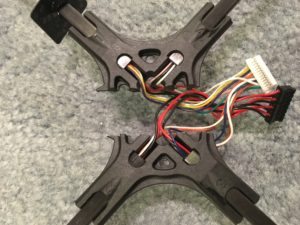Here at Half Chrome we know that when you are first learning to fly a small drone you will crash it. We know this because we also had to learn at some point. So we take our micro, mini, and small drones and put them through and exhaustive regiment of side impact and drop tests.
We drop test from a height of 1 Chewbacca, which is about 6’7″ (2 meters). We fly up that high and then just cut the power, check out the videos below. We also crash test by flying at near top speed into a wall. Pretty simple, but we are the only ones testing these drones like this, and we do it for you. What we have learned is that the little guys hold up quite well. Some of our favorite little drones, like the Eachine H8S and Hubsan X4 models can take seemingly endless abuse. Even the larger Syma X5C and the full sized Syma X8 models can take a ton of abuse. Strangely, the micro drones, like the Cheerson CX series are not quite as robust as the mini drones but they still take a lot of crashes with no major side effects.
The Bigger they are, the Harder they Fall
This is certainly true for drones. Bigger drones have a lot working against them in terms of durability. The main thing is their increased mass (weight). When you double the wingspan of a drone the weight tends to increase by a factor of 8! This is by no means a hard and fast rule, but it gives you a sense of how quickly larger drones can get heavier. Heavier drones fall from the sky faster than little drones meaning they are heavier bricks hitting the ground at faster speeds – not a great combo. First order approximations suggest that a big drone may need to absorb about 64 times the energy of a small drone when it hits the ground in a free fall!

That’s all well and good. You are thinking “thanks a lot, geek!” Lets look at an example that bucks the above trend. The full sized Syma X8 series of drones are about the same size as a DJI Phantom but weigh in at about 1 lb (0.5 kg) as compared to the Phantom at about 3lb (1.4 kg). So the Syma is much more likely to survive a crash than a Phantom. That has certainly been our experience. We accidentally flew our Syma X8 into a solid inatimate object at top speed with no noticable damage. On the other hand, the gimbal of our Phantom 2 got bent up in a 5 foot (1.5 meter) fall. Don’t worry yourself too much, a Phantom is much more stable in wind and it is easier to fly, so you are less likely to crash it in the first place. Fly carefully!
Now sit back and enjoy some very entertaining examples of Half Chrome Drones putting some UAVs through a punishing regiment of drops and side impacts.

 Subscribe to Half Chrome Drones YouTube Channel
Subscribe to Half Chrome Drones YouTube Channel